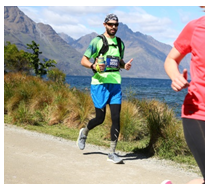Last time (August 2017 blog – The Running Conundrum: Part 1) we discussed the terminology associated with running shoes and how the latest research suggest that we should think of this as a continuum on which all running shoes fit. To recap the terms we discussed were minimalist and maximalist shoes and the 5 key factors (based on the research) that should be considered when looking at the characteristics of that shoe (weight, flexibility, stack height, heel-toe drop and motion control technology). We finished that blog with the questions around:
- What is the best shoe for me to be wearing?
- I have been fitted for this shoe so it must be right…Right?
When looking at running shoes and how appropriate they are for your body you need to ask yourself a few key questions:
- Do I have (or have I had) and injury to my foot, ankle, knee, hip or back?
- How old am I?
- What are my previous footwear habits?
- What is my running experience?
- Do I care about my performance or am I happy with where I am at?
- Am I currently at the start, middle or end oy my training for the season?
- Do I like the feel of my shoes?
- Do I like the colour? (the latter not being that important but to be honest it is a little 🙂 )
I can appreciate that this is a lot to think about when choosing a shoe! But, if I put it to you this way, if you were to run with what is considered the optimal cadence (number of times your feet hit the ground in 1 minute) then each foot would hit the ground 90 times in 1 minute. Over a 20 minute run each foot would hit the ground 1800 times! That’s a lot of repetitions! When thinking of it this way, suddenly choosing the most appropriate shoe is definitely something to think about! Upwards of 70% of running injuries occur in the lower limb and some studies report up to 50% of these occur at the knee (van Gent et.al, 2007). This is why putting time and knowledge into correctly choosing your running shoes are paramount.
This is also one of the reasons why when looking at changing a running shoe the transition to doing so should be very gradual and controlled. The best way that I could think to try and make this as user friendly as possible is to show you the wee flow chart below.
It is extremely important to stress that when looking at changing (or moving to a more minimal) running shoes that this is done in consultation with a health professional and the process is done gradually, because if done to fast the mechanical load will be too high and injury will ensue. The rule of thumb is for every 10 percent change in minimalism this should be done over a 1-2 month period.
So what is the take home message…if you run in traditional shoes and have no injuries and do not want to increase your performance and efficiency – stay in your normal shoes. If you have an injury or want to improve your technique, efficiency and performance then you will need to consider what is between you and the trail and get a professional to guide/assist your decision making 🙂
Joel
Physiotherapist & Exercise Scientist
Certified Professional with “The Running Clinic”


